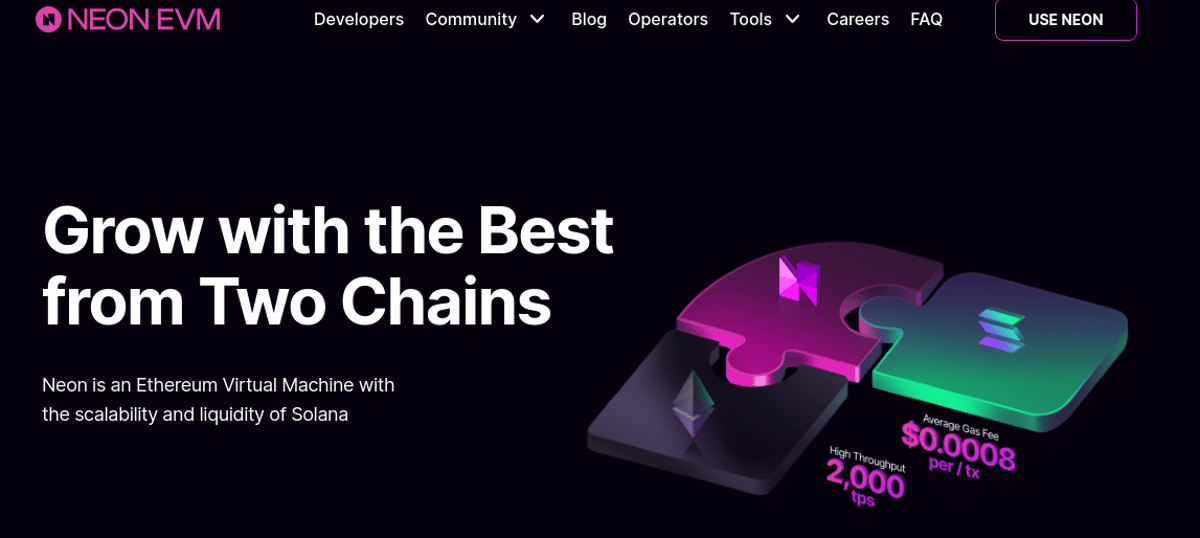Neon EVM, an Ethereum Virtual Machine on Solana, has announced its testnet support for several tokens as an alternative payment for gas fees.
JUST IN: Neon EVM is working on letting users pay transaction fees with different tokens
— Crypto Chiefs News (@CryptoChiefNews) November 17, 2023
According to an exclusive report by TheBlock on November 17, users can now utilize SOL and stablecoins such as USDC and USDT to cover transaction fees rather than the platform’s native token, NEON.
Furthermore, developers can bridge tokens from Ethereum to Solana for integration into the Neon EVM ecosystem’s decentralized applications (dApps) without requiring the NEON token.
This update provides users with various tokens for payment and simplifies the overall experience in the Neon EVM ecosystem.
The payment feature is set to go live on Devnet in the following weeks and on Mainnet in quarter 1 (Q1) of 2024.
Going forward, Neon decentralized autonomous organization (DAO) will determine whether Neon EVM will integrate additional support for more tokens as payment for transaction fees.
Marin Guryeva, the director of Neon Foundation, noted that the firm is excited to introduce a significant improvement to the Neon EVM platform.
She added that the new development would reinforce the platform’s commitment to providing dApps with unparalleled flexibility and users with lower transaction costs and convenience.
Neon EVM Unique Relationship With Solana Blockchain
On July 17, 2023, Neon Labs introduced a technology that enables dApps, originally built on Ethereum, to operate on the Solana blockchain seamlessly.
Exciting news! Our mainnet has officially launched on @Solana Discover more at @TheBlock__ https://t.co/wG0gtKSdvE #NeonEVM #Solana #Etherum
— Neon (@Neon_EVM) July 17, 2023
Guryeva noted that Ethereum is a burgeoning blockchain ecosystem with much to offer to dApp developers and users regarding infrastructure.
On the other hand, Solana is more attractive due to its technical capabilities and perceived position as the next emerging market.
She also highlighted that the Neon EVM will enable dApp developers to tap from the Solana market and enjoy an immersive experience without any difference in interface or tools.
Before the debut of Neon EVM on Solana, Ethereum had a limiting factor centered on how transactions are processed. Smart contracts needed to be executed sequentially, enabling one contract to modify the blockchain state linearly.
In contrast, Solana excelled in the parallel execution of transitions through a state-of-the-art functionality called ‘Sealevel,’ which uses as many cores as possible for the validator, avoiding unwanted lags.
Now operating in Solana, Neon EVM enables anyone using EVM to port over Ethereum transactions to Solana.
This approach allows popular applications like Curve, MakerDAO, and Uniswap to be built natively on Solana with less friction and resources.
Moreso, the cross-chain EVM solution acts as a bridge, allowing these dApps to tap into Solana’s advantages, such as quicker transaction processing (high throughput), faster confirmation of blocks (fast block time), and cost savings in gas fees.
Following its latest support for SOL, USDC, and USDT as payment methods for transaction fees, Neon EVM eliminates the ’empty tank’ issue.
This occurs when developers and traders cannot process outgoing transactions from their crypto wallet without first purchasing NEON from another wallet to cover transaction fees.
Going forward, Neon EVM will continue to innovate and move to more trustless solutions in the coming months.
Read the full article here


